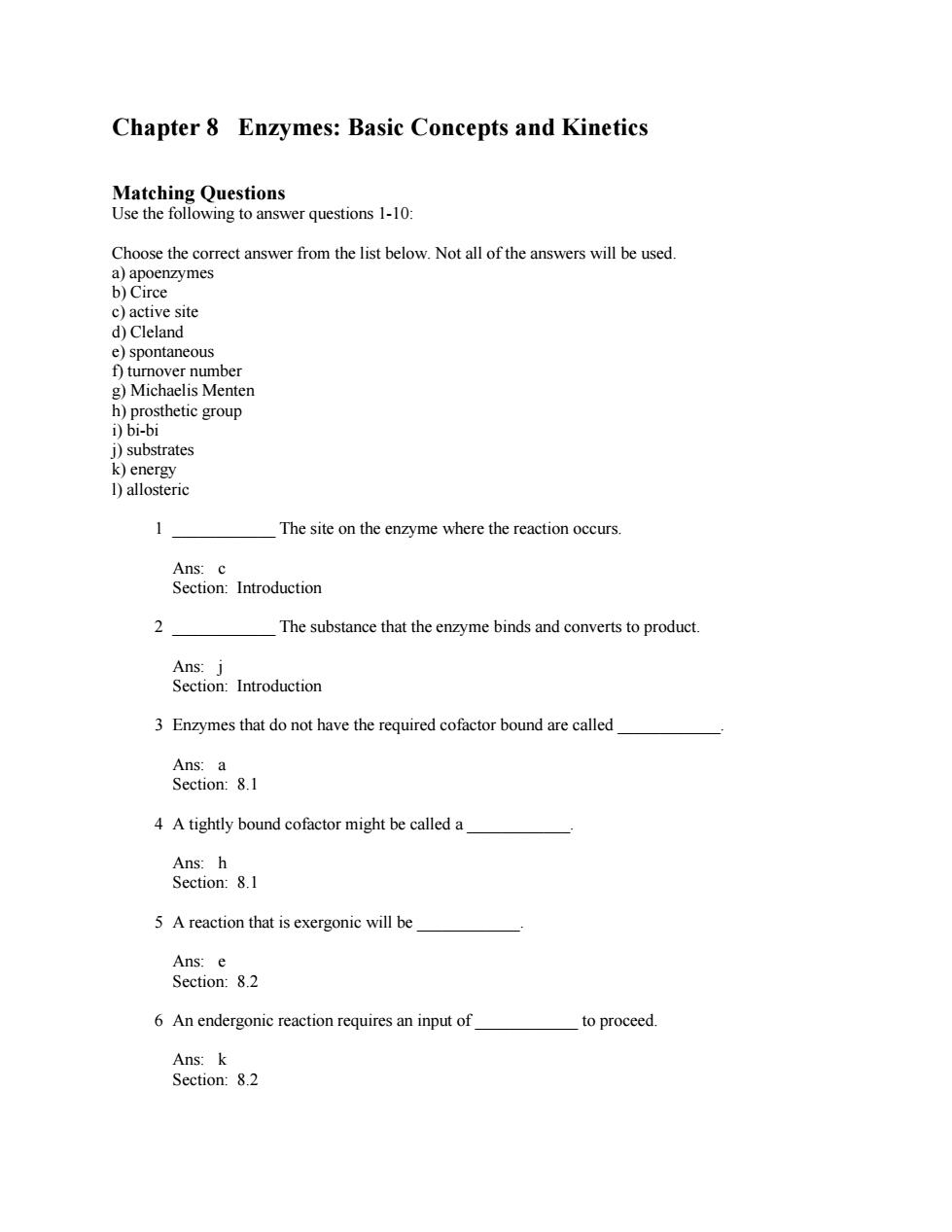
Chapter 8 Enzymes:Basic Concepts and Kinetics Matching Questions Use the following to answer questions 1-10: Choose the correct answer from the list below.Not all of the answers will be used a)apoenzymes b)Circe c)active site d)Cleland e)spontaneous f)turnover number g)Michaelis Menten h)prosthetic group i)bi-bi j)substrates k)energy 1)allosteric The site on the enzyme where the reaction occurs. Ans:c Section:Introduction 2 The substance that the enzyme binds and converts to product. Ans:j Section:Introduction 3 Enzymes that do not have the required cofactor bound are called Ans:a Section:8.1 4 A tightly bound cofactor might be called a Ans:h Section:8.1 5 A reaction that is exergonic will be Ans:e Section:8.2 6 An endergonic reaction requires an input of to proceed. Ans:k Section:8.2
Chapter 8 Enzymes: Basic Concepts and Kinetics Matching Questions Use the following to answer questions 1-10: Choose the correct answer from the list below. Not all of the answers will be used. a) apoenzymes b) Circe c) active site d) Cleland e) spontaneous f) turnover number g) Michaelis Menten h) prosthetic group i) bi-bi j) substrates k) energy l) allosteric 1 ____________ The site on the enzyme where the reaction occurs. Ans: c Section: Introduction 2 ____________ The substance that the enzyme binds and converts to product. Ans: j Section: Introduction 3 Enzymes that do not have the required cofactor bound are called ____________. Ans: a Section: 8.1 4 A tightly bound cofactor might be called a ____________. Ans: h Section: 8.1 5 A reaction that is exergonic will be ____________. Ans: e Section: 8.2 6 An endergonic reaction requires an input of ____________ to proceed. Ans: k Section: 8.2

Chapter 8 Enzymes:Basic Concepts and Kinetics 2 7 The keat is often referred to as the Ans:f Section:8.4 8 Using attractive forces to lure a substrate into an enzyme site is called the effect. Ans:b Section:8.4 9 Enzymes that do not obey Michaelis-Menten kinetics. Ans:I Section:8.4 10 Notation system used to aid in studying bisubstrate enzyme reactions. Ans:d Section:8.4 Fill in the Blank Questions 1 Enzymes accelerate the rate of a chemical reaction by the free energy of activation of the reaction. Ans:lowering Section:8.3 and Introduction 2 The difference between the standard-state free energy,AG,and the biochemical standard-state free energy is that AGo'refers to the standard free-energy change at Ans:pH 7 Section:8.2 3 Most known enzymes are proteins;however,some molecules have been shown to possess catalytic activity. Ans:RNA Section:Introduction 4 Organic cofactors are referred to as Ans:coenzymes Section:8.1 5 A reaction can occur spontaneously only if AG is Ans:negative Section:8.1 6 When AG for a system is zero,the system is at Ans:equilibrium Section:8.1 7 If an enzyme is inactivated by reaction with iodoacetamide,one can conclude that the enzyme contains a critical residue that is required for activity. Ans:cysteine Section:8.5
Chapter 8 Enzymes: Basic Concepts and Kinetics 2 7 The kcat is often referred to as the ____________. Ans: f Section: 8.4 8 Using attractive forces to lure a substrate into an enzyme site is called the ____________ effect. Ans: b Section: 8.4 9 ____________ Enzymes that do not obey Michaelis-Menten kinetics. Ans: l Section: 8.4 10 ____________ Notation system used to aid in studying bisubstrate enzyme reactions. Ans: d Section: 8.4 Fill in the Blank Questions 1 Enzymes accelerate the rate of a chemical reaction by __________________ the free energy of activation of the reaction. Ans: lowering Section: 8.3 and Introduction 2 The difference between the standard-state free energy, ΔGº, and the biochemical standard-state free energy is that ΔGº′ refers to the standard free-energy change at ________. Ans: pH 7 Section: 8.2 3 Most known enzymes are proteins; however, some ___________ molecules have been shown to possess catalytic activity. Ans: RNA Section: Introduction 4 Organic cofactors are referred to as __________________. Ans: coenzymes Section: 8.1 5 A reaction can occur spontaneously only if ΔG is __________________. Ans: negative Section: 8.1 6 When ΔG for a system is zero, the system is at ______________________. Ans: equilibrium Section: 8.1 7 If an enzyme is inactivated by reaction with iodoacetamide, one can conclude that the enzyme contains a critical _________________ residue that is required for activity. Ans: cysteine Section: 8.5
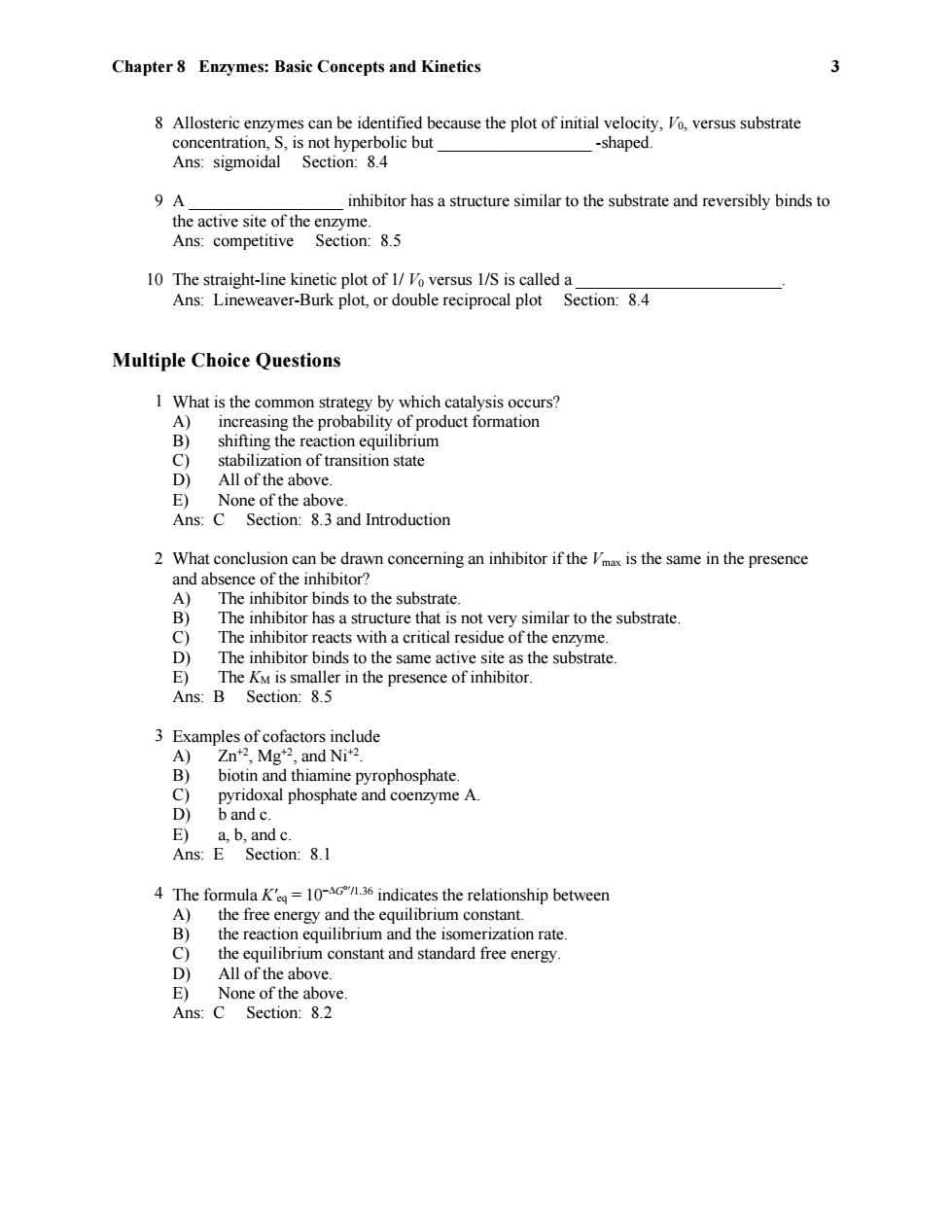
Chapter 8 Enzymes:Basic Concepts and Kinetics 3 8 Allosteric enzymes can be identified because the plot of initial velocity,Vo,versus substrate concentration,S,is not hyperbolic but -shaped. Ans:sigmoidal Section:8.4 9A inhibitor has a structure similar to the substrate and reversibly binds to the active site of the enzyme. Ans:competitive Section:8.5 10 The straight-line kinetic plot of 1/Vo versus 1/S is called a Ans:Lineweaver-Burk plot,or double reciprocal plot Section:8.4 Multiple Choice Questions 1 What is the common strategy by which catalysis occurs? A)increasing the probability of product formation B) shifting the reaction equilibrium C) stabilization of transition state D) All of the above. E) None of the above. Ans:C Section:8.3 and Introduction 2 What conclusion can be drawn concerning an inhibitor if the Vmax is the same in the presence and absence of the inhibitor? A)The inhibitor binds to the substrate. B) The inhibitor has a structure that is not very similar to the substrate. C) The inhibitor reacts with a critical residue of the enzyme. D)The inhibitor binds to the same active site as the substrate. E)The KM is smaller in the presence of inhibitor. Ans:B Section:8.5 3 Examples of cofactors include A) Zn+2,Mg*2,and Ni+2. B) biotin and thiamine pyrophosphate. C) pyridoxal phosphate and coenzyme A. D) b and c. E)a,b,and c. Ans:E Section:8.1 4 The formulaK0 indicates the relationship between A)the free energy and the equilibrium constant. B)the reaction equilibrium and the isomerization rate. C)the equilibrium constant and standard free energy. D)All of the above. E)None of the above. Ans:C Section:8.2
Chapter 8 Enzymes: Basic Concepts and Kinetics 3 8 Allosteric enzymes can be identified because the plot of initial velocity, V0, versus substrate concentration, S, is not hyperbolic but __________________ -shaped. Ans: sigmoidal Section: 8.4 9 A __________________ inhibitor has a structure similar to the substrate and reversibly binds to the active site of the enzyme. Ans: competitive Section: 8.5 10 The straight-line kinetic plot of 1/ V0 versus 1/S is called a ________________________. Ans: Lineweaver-Burk plot, or double reciprocal plot Section: 8.4 Multiple Choice Questions 1 What is the common strategy by which catalysis occurs? A) increasing the probability of product formation B) shifting the reaction equilibrium C) stabilization of transition state D) All of the above. E) None of the above. Ans: C Section: 8.3 and Introduction 2 What conclusion can be drawn concerning an inhibitor if the Vmax is the same in the presence and absence of the inhibitor? A) The inhibitor binds to the substrate. B) The inhibitor has a structure that is not very similar to the substrate. C) The inhibitor reacts with a critical residue of the enzyme. D) The inhibitor binds to the same active site as the substrate. E) The KM is smaller in the presence of inhibitor. Ans: B Section: 8.5 3 Examples of cofactors include A) Zn +2 , Mg +2 , and Ni+2 . B) biotin and thiamine pyrophosphate. C) pyridoxal phosphate and coenzyme A. D) b and c. E) a, b, and c. Ans: E Section: 8.1 4 The formula K'eq = 10 G/1.36 indicates the relationship between A) the free energy and the equilibrium constant. B) the reaction equilibrium and the isomerization rate. C) the equilibrium constant and standard free energy. D) All of the above. E) None of the above. Ans: C Section: 8.2
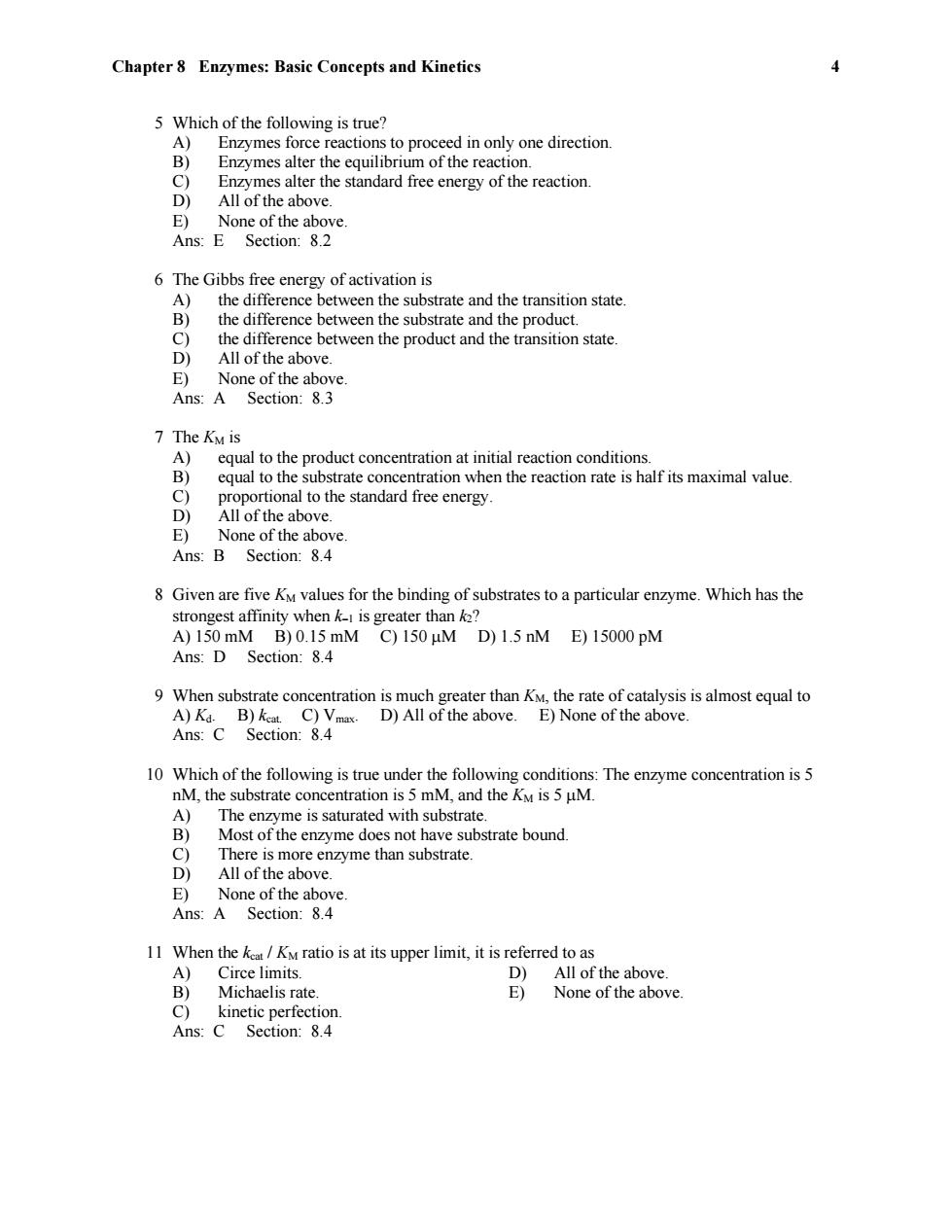
Chapter 8 Enzymes:Basic Concepts and Kinetics 4 5 Which of the following is true? A) Enzymes force reactions to proceed in only one direction. B) Enzymes alter the equilibrium of the reaction. c) Enzymes alter the standard free energy of the reaction. D) All of the above. E)None of the above Ans:E Section:8.2 6 The Gibbs free energy of activation is A)the difference between the substrate and the transition state. B) the difference between the substrate and the product. C)the difference between the product and the transition state. D)All of the above. E)None of the above. Ans:A Section:8.3 7 The KM is A)equal to the product concentration at initial reaction conditions B) equal to the substrate concentration when the reaction rate is half its maximal value. C) proportional to the standard free energy. D) All of the above. E) None of the above. Ans:B Section:84 8 Given are five KM values for the binding of substrates to a particular enzyme.Which has the strongest affinity when k-i is greater than k2? A)150mMB)0.15mMC)150μMD)1.5nME)15000pM Ans:D Section:8.4 9 When substrate concentration is much greater than KM,the rate of catalysis is almost equal to A)Ka.B)keat.C)Vmax.D)All of the above.E)None of the above. Ans:C Section:8.4 10 Which of the following is true under the following conditions:The enzyme concentration is 5 nM,the substrate concentration is 5 mM,and the KM is 5 uM. A)The enzyme is saturated with substrate. B) Most of the enzyme does not have substrate bound. C) There is more enzyme than substrate. D)All of the above. E)None of the above Ans:A Section:8.4 11 When the keat KM ratio is at its upper limit,it is referred to as A)Circe limits. D) All of the above. B)Michaelis rate E) None of the above. C) kinetic perfection. Ans:C Section:8.4
Chapter 8 Enzymes: Basic Concepts and Kinetics 4 5 Which of the following is true? A) Enzymes force reactions to proceed in only one direction. B) Enzymes alter the equilibrium of the reaction. C) Enzymes alter the standard free energy of the reaction. D) All of the above. E) None of the above. Ans: E Section: 8.2 6 The Gibbs free energy of activation is A) the difference between the substrate and the transition state. B) the difference between the substrate and the product. C) the difference between the product and the transition state. D) All of the above. E) None of the above. Ans: A Section: 8.3 7 The KM is A) equal to the product concentration at initial reaction conditions. B) equal to the substrate concentration when the reaction rate is half its maximal value. C) proportional to the standard free energy. D) All of the above. E) None of the above. Ans: B Section: 8.4 8 Given are five KM values for the binding of substrates to a particular enzyme. Which has the strongest affinity when k1 is greater than k2? A) 150 mM B) 0.15 mM C) 150 M D) 1.5 nM E) 15000 pM Ans: D Section: 8.4 9 When substrate concentration is much greater than KM, the rate of catalysis is almost equal to A) Kd. B) kcat. C) Vmax. D) All of the above. E) None of the above. Ans: C Section: 8.4 10 Which of the following is true under the following conditions: The enzyme concentration is 5 nM, the substrate concentration is 5 mM, and the KM is 5 M. A) The enzyme is saturated with substrate. B) Most of the enzyme does not have substrate bound. C) There is more enzyme than substrate. D) All of the above. E) None of the above. Ans: A Section: 8.4 11 When the kcat / KM ratio is at its upper limit, it is referred to as A) Circe limits. D) All of the above. B) Michaelis rate. E) None of the above. C) kinetic perfection. Ans: C Section: 8.4
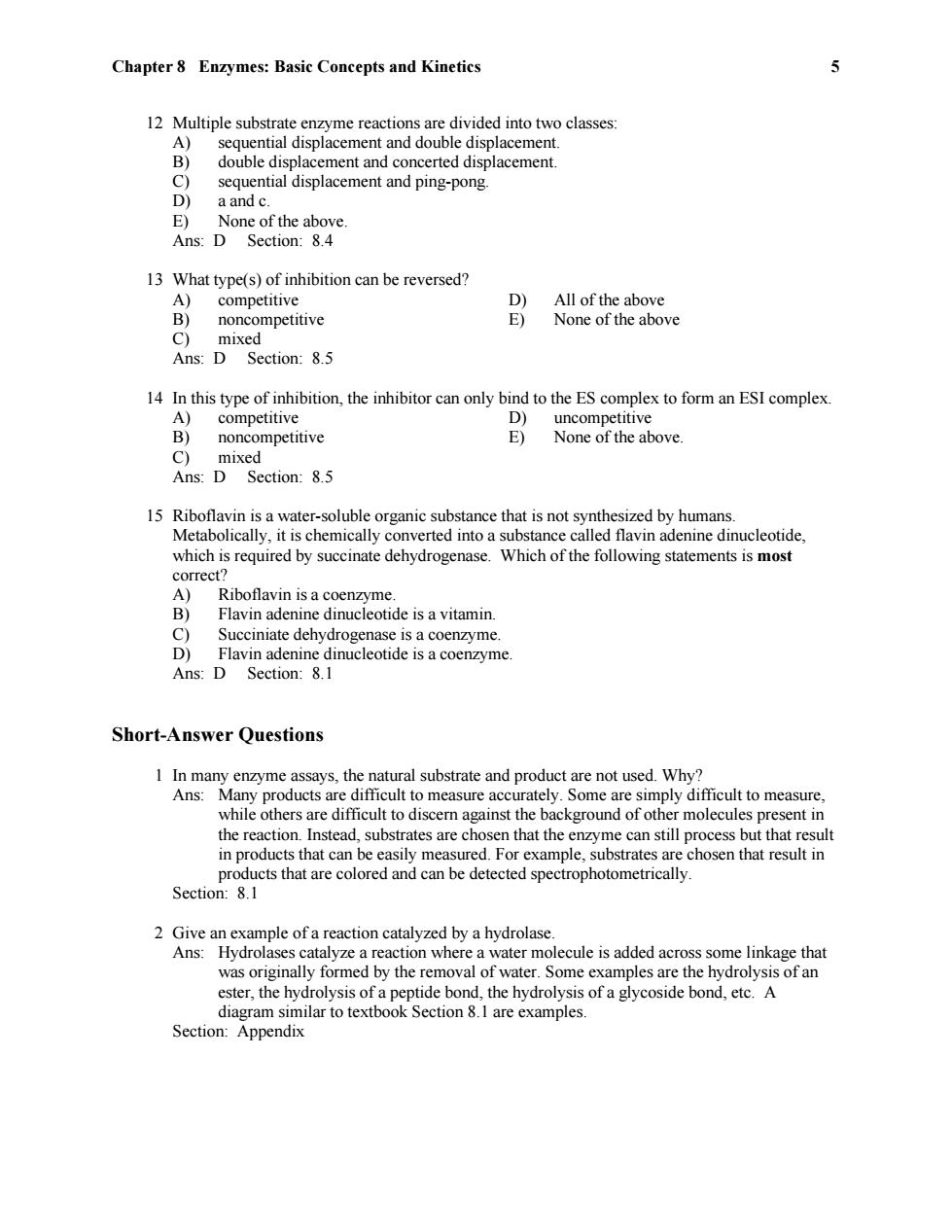
Chapter 8 Enzymes:Basic Concepts and Kinetics 12 Multiple substrate enzyme reactions are divided into two classes: A) sequential displacement and double displacement. B) double displacement and concerted displacement. c) sequential displacement and ping-pong. D) a and c. E) None of the above. Ans:D Section:8.4 13 What type(s)of inhibition can be reversed? A) competitive D) All of the above B) noncompetitive E) None of the above C) mixed Ans:D Section:8.5 14 In this type of inhibition,the inhibitor can only bind to the ES complex to form an ESI complex. A) competitive D) uncompetitive B) noncompetitive E) None of the above. C)mixed Ans:D Section:8.5 15 Riboflavin is a water-soluble organic substance that is not synthesized by humans. Metabolically,it is chemically converted into a substance called flavin adenine dinucleotide, which is required by succinate dehydrogenase.Which of the following statements is most correct? A Riboflavin is a coenzyme. B) Flavin adenine dinucleotide is a vitamin. C) Succiniate dehydrogenase is a coenzyme. D) Flavin adenine dinucleotide is a coenzyme. Ans:D Section:8.1 Short-Answer Questions 1 In many enzyme assays,the natural substrate and product are not used.Why? Ans:Many products are difficult to measure accurately.Some are simply difficult to measure, while others are difficult to discern against the background of other molecules present in the reaction.Instead,substrates are chosen that the enzyme can still process but that result in products that can be easily measured.For example,substrates are chosen that result in products that are colored and can be detected spectrophotometrically. Section:8.1 2 Give an example of a reaction catalyzed by a hydrolase. Ans:Hydrolases catalyze a reaction where a water molecule is added across some linkage that was originally formed by the removal of water.Some examples are the hydrolysis of an ester,the hydrolysis of a peptide bond,the hydrolysis of a glycoside bond,etc.A diagram similar to textbook Section 8.1 are examples. Section:Appendix
Chapter 8 Enzymes: Basic Concepts and Kinetics 5 12 Multiple substrate enzyme reactions are divided into two classes: A) sequential displacement and double displacement. B) double displacement and concerted displacement. C) sequential displacement and ping-pong. D) a and c. E) None of the above. Ans: D Section: 8.4 13 What type(s) of inhibition can be reversed? A) competitive D) All of the above B) noncompetitive E) None of the above C) mixed Ans: D Section: 8.5 14 In this type of inhibition, the inhibitor can only bind to the ES complex to form an ESI complex. A) competitive D) uncompetitive B) noncompetitive E) None of the above. C) mixed Ans: D Section: 8.5 15 Riboflavin is a water-soluble organic substance that is not synthesized by humans. Metabolically, it is chemically converted into a substance called flavin adenine dinucleotide, which is required by succinate dehydrogenase. Which of the following statements is most correct? A) Riboflavin is a coenzyme. B) Flavin adenine dinucleotide is a vitamin. C) Succiniate dehydrogenase is a coenzyme. D) Flavin adenine dinucleotide is a coenzyme. Ans: D Section: 8.1 Short-Answer Questions 1 In many enzyme assays, the natural substrate and product are not used. Why? Ans: Many products are difficult to measure accurately. Some are simply difficult to measure, while others are difficult to discern against the background of other molecules present in the reaction. Instead, substrates are chosen that the enzyme can still process but that result in products that can be easily measured. For example, substrates are chosen that result in products that are colored and can be detected spectrophotometrically. Section: 8.1 2 Give an example of a reaction catalyzed by a hydrolase. Ans: Hydrolases catalyze a reaction where a water molecule is added across some linkage that was originally formed by the removal of water. Some examples are the hydrolysis of an ester, the hydrolysis of a peptide bond, the hydrolysis of a glycoside bond, etc. A diagram similar to textbook Section 8.1 are examples. Section: Appendix

Chapter 8 Enzymes:Basic Concepts and Kinetics 6 3 There are six basic categories of enzymes.List the categories and define the type of reaction. Ans:The categories include oxidoreductases (oxidation-reduction reactions).transferases (group transfers),hydrolases(hydrolysis reactions),lyases(addition or removal across a double bond),isomerases(intramolecular group transfer),and ligases(ATP-dependent ligation of substrates).See textbook Table 8.3 for further details. Section:8.1 4 How is the substrate bound to the active site? Ans:The active site is a small part of the total enzyme structure.It is usually a three- dimensional cleft or crevice,which is formed by amino acid residues from different regions of the polypeptide chain.The substrate is bound by multiple noncovalent attractions such as electrostatic interactions,hydrogen bonds,van der Waals forces,and hydrophobic interactions.The specificity is dependent on the precise arrangement of the various functional groups in the binding site. Section:8.3 5 You believe a substrate fits into a cleft like a key into a lock,but your roommate does not.Who is right? Ans:You are both partially correct.Like a lock and key,the substrate fits precisely into the enzyme.However,the site is not a rigid cleft,but is flexible.Thus,it is possible for the substrate to actually modify the shape of the site a bit,a hypothesis known as induced fit. See textbook Figures 8.9 and 8.10 for further detail. Section:8.3 6 In an enzymatic reaction in a test tube,the reaction will eventually reach equilibrium.Why does this not happen in living organisms? Ans:In a cell,the product may be utilized for a subsequent reaction,thus the reaction may not reach equilibrium. Section:8.3 7 What is the Michaelis-Menten equation?Define all parameters. Ans:Vo=Vmax(S/(S +KM)) Initial velocity Vo Maximum velocity Vmax Substrate concentration S Michaelis constant KM Section:8.4
Chapter 8 Enzymes: Basic Concepts and Kinetics 6 3 There are six basic categories of enzymes. List the categories and define the type of reaction. Ans: The categories include oxidoreductases (oxidation-reduction reactions), transferases (group transfers), hydrolases (hydrolysis reactions), lyases (addition or removal across a double bond), isomerases (intramolecular group transfer), and ligases (ATP-dependent ligation of substrates). See textbook Table 8.3 for further details. Section: 8.1 4 How is the substrate bound to the active site? Ans: The active site is a small part of the total enzyme structure. It is usually a three- dimensional cleft or crevice, which is formed by amino acid residues from different regions of the polypeptide chain. The substrate is bound by multiple noncovalent attractions such as electrostatic interactions, hydrogen bonds, van der Waals forces, and hydrophobic interactions. The specificity is dependent on the precise arrangement of the various functional groups in the binding site. Section: 8.3 5 You believe a substrate fits into a cleft like a key into a lock, but your roommate does not. Who is right? Ans: You are both partially correct. Like a lock and key, the substrate fits precisely into the enzyme. However, the site is not a rigid cleft, but is flexible. Thus, it is possible for the substrate to actually modify the shape of the site a bit, a hypothesis known as induced fit. See textbook Figures 8.9 and 8.10 for further detail. Section: 8.3 6 In an enzymatic reaction in a test tube, the reaction will eventually reach equilibrium. Why does this not happen in living organisms? Ans: In a cell, the product may be utilized for a subsequent reaction, thus the reaction may not reach equilibrium. Section: 8.3 7 What is the Michaelis-Menten equation? Define all parameters. Ans: V0 = Vmax(S/(S + KM)) Initial velocity V0 Maximum velocity Vmax Substrate concentration S Michaelis constant KM Section: 8.4
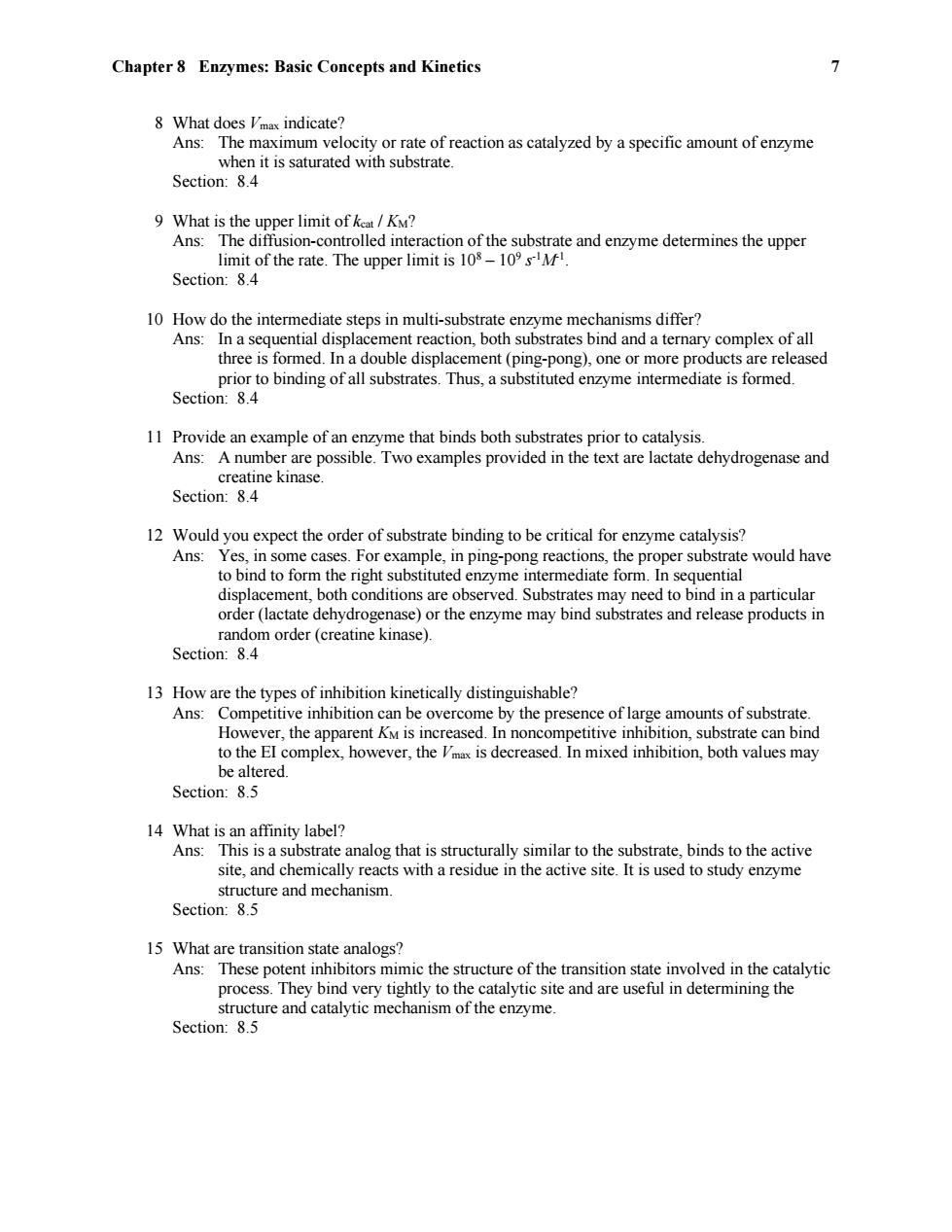
Chapter 8 Enzymes:Basic Concepts and Kinetics 7 8 What does Imax indicate? Ans:The maximum velocity or rate of reaction as catalyzed by a specific amount of enzyme when it is saturated with substrate. Section:8.4 9 What is the upper limit of keat KM? Ans:The diffusion-controlled interaction of the substrate and enzyme determines the upper limit of the rate.The upper limit is 108-10%sM. Section:8.4 10 How do the intermediate steps in multi-substrate enzyme mechanisms differ? Ans:In a sequential displacement reaction,both substrates bind and a ternary complex of all three is formed.In a double displacement(ping-pong),one or more products are released prior to binding of all substrates.Thus,a substituted enzyme intermediate is formed. Section:8.4 11 Provide an example of an enzyme that binds both substrates prior to catalysis. Ans:A number are possible.Two examples provided in the text are lactate dehydrogenase and creatine kinase. Section:8.4 12 Would you expect the order of substrate binding to be critical for enzyme catalysis? Ans:Yes,in some cases.For example,in ping-pong reactions,the proper substrate would have to bind to form the right substituted enzyme intermediate form.In sequential displacement,both conditions are observed.Substrates may need to bind in a particular order(lactate dehydrogenase)or the enzyme may bind substrates and release products in random order (creatine kinase). Section:8.4 13 How are the types of inhibition kinetically distinguishable? Ans:Competitive inhibition can be overcome by the presence of large amounts of substrate. However,the apparent KM is increased.In noncompetitive inhibition,substrate can bind to the EI complex,however,the Vmax is decreased.In mixed inhibition,both values may be altered. Section:8.5 14 What is an affinity label? Ans:This is a substrate analog that is structurally similar to the substrate,binds to the active site,and chemically reacts with a residue in the active site.It is used to study enzyme structure and mechanism. Section:8.5 15 What are transition state analogs? Ans:These potent inhibitors mimic the structure of the transition state involved in the catalytic process.They bind very tightly to the catalytic site and are useful in determining the structure and catalytic mechanism of the enzyme. Section:8.5
Chapter 8 Enzymes: Basic Concepts and Kinetics 7 8 What does Vmax indicate? Ans: The maximum velocity or rate of reaction as catalyzed by a specific amount of enzyme when it is saturated with substrate. Section: 8.4 9 What is the upper limit of kcat / KM? Ans: The diffusion-controlled interaction of the substrate and enzyme determines the upper limit of the rate. The upper limit is 10 8 – 10 9 s -1M-1 . Section: 8.4 10 How do the intermediate steps in multi-substrate enzyme mechanisms differ? Ans: In a sequential displacement reaction, both substrates bind and a ternary complex of all three is formed. In a double displacement (ping-pong), one or more products are released prior to binding of all substrates. Thus, a substituted enzyme intermediate is formed. Section: 8.4 11 Provide an example of an enzyme that binds both substrates prior to catalysis. Ans: A number are possible. Two examples provided in the text are lactate dehydrogenase and creatine kinase. Section: 8.4 12 Would you expect the order of substrate binding to be critical for enzyme catalysis? Ans: Yes, in some cases. For example, in ping-pong reactions, the proper substrate would have to bind to form the right substituted enzyme intermediate form. In sequential displacement, both conditions are observed. Substrates may need to bind in a particular order (lactate dehydrogenase) or the enzyme may bind substrates and release products in random order (creatine kinase). Section: 8.4 13 How are the types of inhibition kinetically distinguishable? Ans: Competitive inhibition can be overcome by the presence of large amounts of substrate. However, the apparent KM is increased. In noncompetitive inhibition, substrate can bind to the EI complex, however, the Vmax is decreased. In mixed inhibition, both values may be altered. Section: 8.5 14 What is an affinity label? Ans: This is a substrate analog that is structurally similar to the substrate, binds to the active site, and chemically reacts with a residue in the active site. It is used to study enzyme structure and mechanism. Section: 8.5 15 What are transition state analogs? Ans: These potent inhibitors mimic the structure of the transition state involved in the catalytic process. They bind very tightly to the catalytic site and are useful in determining the structure and catalytic mechanism of the enzyme. Section: 8.5